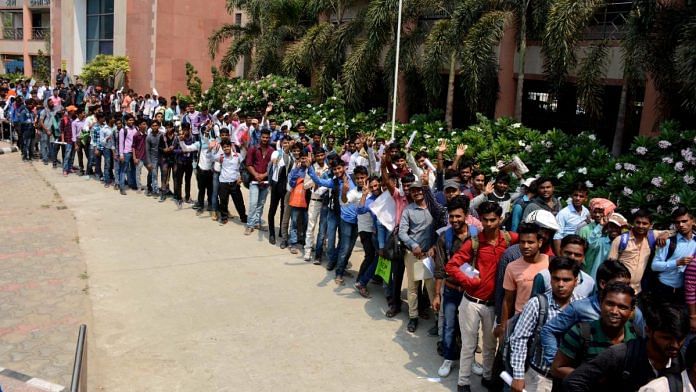New Delhi: While the overall rate of unemployment in India fell in 2021-22 to 6.6 percent compared to 8.7 percent in 2017-18, a significant 42 percent of India’s graduates under the age of 25 remained unemployed, a report by the Centre for Sustainable Employment (CSE) at Azim Premji University has found.
Graduates under 25 years of age in India have the highest unemployment rate compared to those with higher educational levels for the same age group, the report, released Wednesday, states.
Moreover, while the gender pay disparity has shrunk over time, it is still significantly higher than the income disparity among different castes and religions. The disparity in earnings is greatest among self-employed individuals and SC/ST women employees.
The report titled ‘State of Working India 2023 — Social Identities and Labour Market Outcomes’ also found that upward mobility has increased, and caste-based segregation and gender disparity has reduced across labour markets. However, India has performed poorly compared to the average developing country when it comes to linking growth to jobs.
The report utilised a variety of data sources, including surveys conducted by the National Statistical Office (NSO), such as Employment-Unemployment Surveys and Periodic Labour Force Surveys, as well as the India Working Survey, a collaborative effort between researchers from Azim Premji University, Indian Institute of Management Bangalore, and University of Western Australia.
Also read: ‘Unemployment is tip of the iceberg’: India’s lack of jobs threatens its youth despite 6.5% growth
More women working, but out of distress
While the report highlights positive changes in gender-based earning disparities, it also showed that traditional gender norms continue to influence the employment decisions of women.
In 2004, women in salaried positions earned 70 percent of what men earned. This improved to 76 percent in 2017 and remained constant in 2020-21.
Notably, the report said that the rise in female workforce participation rate in 2020-21 after years of decline is a result of a shift from domestic duties to self-employment.
The report found that 60 percent of the working women were self-employed following the Covid-19 pandemic as compared to 50 percent before the pandemic.
However, this isn’t good news, the analysis found. According to the report, this increase in self-employment appears to be distress-led due to economic slowdown and the impact of the pandemic. As a result, earnings from self-employment have declined in real terms since 2019.
The report added that self-employment earnings in 2022 were only 85 percent of what they were in the first quarter of 2019.
While, between 2004 and 2017, approximately three million regular wage jobs were generated annually, the annual figure rose to five million between 2017 and 2019. However, since 2019, the growth in the creation of regular wage jobs has decreased, due to both economic slowdown and the impact of the pandemic.
The ‘mother-in-law’ impact
The report found that the employment status of a mother-in-law in a household had a significant impact on whether the daughter-in-law worked or not — married women in rural and urban India were, respectively, 20 percent and 30 percent less likely to be employed if they had an unemployed mother-in-law living with them, as compared to if the mother-in-law was not living with them.
However, if the mother-in-law was herself working and living with them, then the daughters-in-law were 50 percent (rural) and 70 percent (urban) more likely to be employed as compared to if they lived apart.
Traditional barriers hamper access to work
Intergenerational mobility has been weaker for workers belonging to SC and ST communities than for workers belonging to general castes, said the report.
The data showed that 75.6 percent of SC/ST men who engaged in casual wage employment in 2018 also had sons engaged in casual wage work. This percentage was 86.5 percent in 2004, indicating that sons of SC/ST casual wage workers have shifted to other types of employment, mostly informal regular wage work. For the general caste category, the percentage decreased from 83.2 percent in 2004 to 53.2 percent in 2018.
In terms of caste-based participation in the labour force, the report found that while in the early 1980s, SC labourers were more than five times over-represented in waste-related work and more than four times over-represented in leather-related work, this disparity has decreased significantly over time.
It also showed that women SC/ST workers earn only 54 percent of what upper caste women earn in salaried work.
The report also sheds light on the representation of entrepreneurs from lower caste groups. Even in small businesses, SC and ST owners are underrepresented relative to their overall workforce representation. This underrepresentation is even more pronounced in companies with more than 20 employees. SC/ST employees are significantly more likely to be employed on a temporary basis.
Employment structure, the report added, varies far more across gender and caste identities than it does across religion. However, Muslims were less likely to hold regular wage employment and more likely to be self-employed or work on a casual wage basis over the entire four-decade period. Controlling for caste, level of education, and other relevant characteristics, urban Muslim women were much less likely to be employed than Hindu women.
(Edited by Zinnia Ray Chaudhuri)
Also read: Haryana govt wants private sector to hire 75% local residents, but youth don’t want factory jobs



